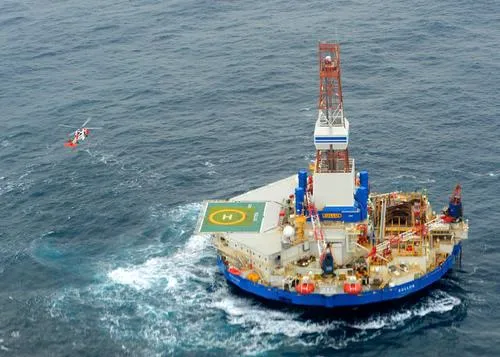Arctic Offshore Drilling Still Going Poorly As Shell’s Rig Runs Aground
The recent mishap is part of a string of troubles that Shell has encountered in its efforts to drill in the frigid Gulf
/https://tf-cmsv2-smithsonianmag-media.s3.amazonaws.com/filer/2013010211201801_02_2012_kulluk-crew.jpg)
On Monday night, the Kulluk—one of Shell’s two Arctic offshore oil drilling platforms—ran aground after having been set adrift by stormy weather, says The New York Times.
The Kulluk, which does not have a propulsion system of its own, ran into trouble late last week when its tow ship, the Aiviq, lost engine power and the towline separated. A Coast Guard cutter and other ships arrived, and crews struggled through Monday, in seas up to 35 feet, to reconnect tow lines to the rig, succeeding several times. But each time the lines separated.
On Monday night, the Kulluk, 266 feet in diameter, broke free from one tow ship and the Coast Guard ordered a second ship to disconnect, fearing for the safety of its crew.
The Kulluk is currently stuck on the shores of Sitkalidak Island, says the Times, a small island to the southeast of the Alaskan peninsula in the Gulf of Alaska.

According to the BBC, efforts to wrest the stranded platform from its new-found perch have been called off for the time being because of the continuing bad weather. The platform does appear to be stable, and the risk of it dumping its on-board stores of diesel and oil seems to be low.
The recent mishap is part of a string of troubles that Shell has encountered in its efforts to drill in frigid northern waters. In September, drilling was called off as sea ice threatened the rig. Days later, an important part of the drilling equipment broke during tests. This isn’t even Shell’s first trouble with wayward ships, says the Los Angeles Times: in July, another of Shell’s drilling rigs, the Discoverer, was nearly beached by high winds.
The dash to drill for offshore oil near Alaska is the most recent leg in a decades long push to drive drilling in the Arctic. In 1959, Bawden Drilling became the “first company to drill beyond the Arctic Circle,” says the Canadian Petroleum Hall of Fame. The 1970s saw the highly-contested Trans-Alaska Pipeline constructed to ferry crude south. From the late 60s through the 80s, says the Geological Association of Canada , “more than 400 wells were drilled.”
Eighteen petroleum fields had been discovered in the Arctic Islands and 47 in the Beaufort-Mackenzie area. But the costs of developing the fields and getting the oil and gas to market were huge, and low oil prices meant that, for the time being, the discoveries just weren’t economic.
Today it’s a different story. High oil and gas prices, and the promise of new pipeline systems that will make delivering the resources easier have reawakened interest the North’s vast oil and gas potential.
“While this latest accident may prove harmless to the environment,” says New Scientist, “it will give environmentalists another stick with which to beat Shell. The growing catalogue of mishaps looks very bad for the company.”
More from Smithsonian.com:
/https://tf-cmsv2-smithsonianmag-media.s3.amazonaws.com/accounts/headshot/smartnews-colin-schultz-240.jpg)
/https://tf-cmsv2-smithsonianmag-media.s3.amazonaws.com/accounts/headshot/smartnews-colin-schultz-240.jpg)